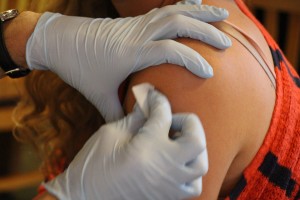
Is there such a thing as too much medicine?
Unnecessary tests and procedures are estimated to cost $250 billion to $800 billion a year in the United States, or between 10 and 30 percent of all health care spending, according to a 2012 report in the British Journal of Medicine.
The problem is so bad that doctors themselves are worried. And on Tuesday, the American Academy of Dermatology became the latest specialty group to start fighting back. The group published a list of five potentially unnecessary dermatologic procedures.
The “Choosing Wisely” list ranges from minor things like oral antibiotics given in uncomplicated cases of eczema to a serious procedure like surgical sampling of lymph nodes in early melanoma skin cancer.
“It is important for patients with skin, hair or nails concerns to talk with and ask questions of their dermatologist about medical care they may not need,” said Dr. Brett M. Coldiron, incoming president of the Academy of Dermatology. “This ‘Choosing Wisely’ list can help patients save time and money by avoiding medical treatments and tests their condition may not require.”
The list is not just meant for doctors — the idea is to empower patients to be able to ask questions and avoid potentially unnecessary medical treatment.
“If they have a melanoma, everybody is in a panic to get everything possible done and it doesn’t benefit you. It hurts you, and they need to know that,” Dr. Coldiron said. “If the patients have heard that it may not be necessary, then they may ask their doctor, is this necessary? And that would be a wonderful thing to have that discussion.”
The “Choosing Wisely” list, started in 2011 in conjunction with Consumer Reports, is a brainchild of the American Board of Internal Medicine Foundation. The idea is to encourage conversations between patients and doctors, promoting care that is free from harm, necessary and rooted in evidence.
Dermatologists are not the only ones to release a list. They are joining more than 80 other medical specialty societies, regional health collaboratives and consumer partners — all of whom have released similar lists that cover more than 250 tests and procedures that are overused and potentially inappropriate. Nine other specialty groups released their lists this month, including the American College of Emergency Physicians and the American College of Rheumatology.
Dr. Elizabeth Gould has been in private practice in Palo Alto and Menlo Park for 20 years. She works with her father, a dermatologist who has been practicing since 1964. She recently had a patient who came to her with two minor sites of basal cell skin cancer on his back and neck. He had been told by another dermatologist that he should get Mohs surgery, a long and expensive procedure in which every slice of skin is examined under a microscope during the surgery. It allows doctors to only remove a very small amount of skin and thus is suited to a cancer on the face where large scars can be disfiguring. In this case, however, the cancer could be removed without an expensive surgery. After a discussion with Dr. Gould, the patient opted not to have Mohs — saving himself and the medical system a lot of money.
Dr. Gould believes that the “Choosing Wisely” list could be helpful in having these sorts of discussions with patients. She also said it was helpful for doctors themselves, because it reminds them about standards of care. “These are things that I haven’t heard spoken before and they’re definitely true,” she said.
Physicians interviewed for this article said they try to ease the financial burden on patients. Some, however, were worried that an emphasis on cost could be detrimental to their patients. “In terms of judging what’s most appropriate for a patient, I don’t think that cost should influence my judgment,” said Dr. Divya Railan, a dermatologist who has been in private practice in Menlo Park for 10 years.
Dr. Coldiron agreed that patient outcome was the most important consideration. But cost and patient advocacy are not mutually exclusive, he said. “There are a lot of simple things that actually hurt patients or don’t help them…I think that first and foremost a physician is an advocate for his patient. And I don’t see that there’s any conflict with that.”
All three physicians agreed that soaring costs were a problem in health care.
“It’s crucial,” Dr. Coldiron said. “We’ve got a country that’s almost bankrupt. We’re hugely in debt. We’ve got a Medicare program that they say is unsustainable, and I think that costs are very important. If you can treat somebody just as well at a fraction of the cost, I think you should do it. It’s not because we want to deny care and it’s not because we want to give anyone short shift. It’s because we want to husband our resources. If you waste money — at the end of the month there’s not any money left to treat people with, and that’s not going to be a good thing.”
And yet none of the physicians reported receiving any formal preparation about cost containment during their medical training. Dr. Coldiron recalled asking about the cost of medications as a medical resident. His queries were met with angry dismissal.
But he feels the system now is changing. “I think that’s an attitude that’s almost gone away. I think that’s toast,” he said.
Dr. Gould echoed his sentiments: “Every practitioner has a huge responsibility to think about cost containment for every patient that walks through the door.”
